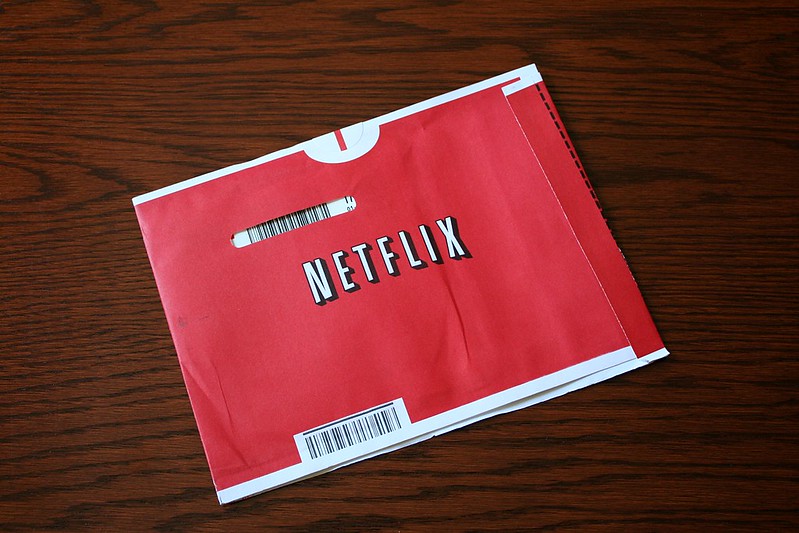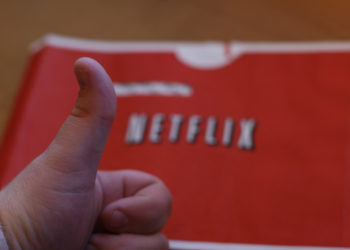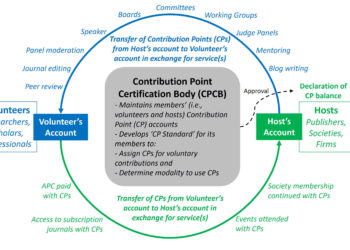At the end of September, the last red envelope with a physical DVD was mailed out by Netflix. If you’re of a certain age, you recall a revolutionary service which could offer you a nearly unlimited catalog of titles that you could get without the painful trips to the rental store, or the more repulsive daily fines for being late in your returns. The company grew quickly from its initial catalog and soon became a primary source for video content for many people for several years. The company had always envisioned this day. “There’s a reason we didn’t call the company ‘DVD-by-Mail.com.’” was the mantra of Reed Hastings, the company’s co-founder and CEO. Now that day has arrived.

What is interesting is that the DVD-by-mail era, which followed on the heels of the three decades of video rental stores, was centered around the notion of convenience and choice. “Have you ever watched a movie the moment you wanted to?”, it was promised. “You will,” according to ATT — though many of these things are available, ATT isn’t the source in most cases. When Netflix announced its streaming service in 2007, its DVD by mail service had a catalog of more than 70,000 discs. At the time of the streaming launch announcement, the expected catalog of the video-on-demand service was described as “fairly thin, with only 1,000 titles available.” People mused whether people would be satisfied with the limited availability of the service.
As of this writing, the Netflix streaming catalog contains 3,992 movies. While this is not the full catalog available to you, since there are shows, specials, and other things on the service, it is a reasonably reliable figure of approximately the amount of content on offer. The service notes that it adds “new movies to this list every day.” However, Netflix also regularly posts a list of titles that are “leaving soon” as well. The average number of titles therefore is neither growing, nor shrinking, but rather hovers around a consistent level in the mid-thousands range. This is only about 6% of the catalog one could access previously in the DVD-circulating era.
An article in Wired by Angela Wattercutter argued “The Algorithms Won” the streaming wars and proclaimed as much in the title. She argues that the reasons there are only a few thousand titles is that people are pushed toward the “top” titles through the algorithms and therefore a limited number are actually desired. Algorithms do drive our viewing selections, primarily by limiting what you are presented with as options, even in search results. Also, there is some research that as the number of options increases, the fewer movies are actually watched and I’m sure this feeds into the decisions by Netflix about how much to provide as the company is highly data-driven.
From my perspective, it’s actually more complex than that. In part, licensing and the lawyers won. It is not (entirely – though it is true in part) that the algorithms drive users to a smaller and smaller subset of popular, or even niche content. Realistically, the licensing arrangements by the producers and owners of the content, which allow for only certain content to be released at certain times or on certain platforms are having a greater effect on people’s viewing habits. How often have you thought, “I’d like to watch [or read/listen to] XXXX again,” only to be stymied by the fact that it is not available.
As various services have begun competing in the streaming space, companies have begun to tie down their content to a walled-garden service. One needs to now know that this movie was released by this studio, which was acquired by this conglomerate now, and therefore the only way you can know whether you can stream it is to subscribe to their streaming platform.
It is worth asking whether we should care about the end of another physical delivery service. In principle, the answer should be no. Services come and go. What was a good service in one era isn’t needed when the technology changes fundamentally. Last summer, I was touring a home and garden of a famous explorer and philanthropist outside of Baltimore. His family became rich manufacturing leather belts, which were important for horse drawn transportation and for early factories, but became irrelevant in an era of cars and electrical motors. In a similar way, Blockbuster Video stores and 35-mm film mini-processing labs both thrived in their era, but are now just memories.
More importantly for our community, we should consider the value not necessarily of the service, but of the underlying nature of the thing that made distribution of DVDs and libraires possible: the concept of ownership. Netflix could purchase DVDs by the truckload and rent them out to users because it owned the physical copies. Libraries similarly rely on this principles of first sale and copyright exhaustion as rationales for their right to circulate the content they purchase. Increasingly, you and I are not able to purchase copies of movies, or music, or digital books. These are all licensed. And while you might think you’ve purchased a digital movie or book, there is absolutely no guarantee that when the service disappears or you’ve violated some term of service you hadn’t read, that your purchases will transfer in any form (just one link among thousands).
Interestingly, last month at a roundtable I participated in before the leadership of the Committee on House Administration on the topic of copyright modernization, this topic came up in a somewhat strange way. One of the questions put before the panel was whether content deposited to the Library of Congress via the Copyright Office should be encrypted or otherwise protected by technical protection measures. Representatives of the Copyright Alliance and the RIAA protested that the availability of raw, unprotected files in the world, that exist outside of their systems presented an existential risk to those companies.
Setting aside the question of whether those companies themselves have a good track record of protecting their intellectual property (as just two examples, see the Sony hack and the Universal fire), there are two core problems with this argument. First is the underlying presumption that those in the library community cannot be trusted with the long-term preservation of published and publicly available content. This is patently absurd, as the Library of Congress has had decades of experience protecting not only the unpublished content it holds because of Copyright Registration, but also the vast amount of secure and proprietary information it also holds in its collection. We can all be reasonably certain that the Congressional secrets that the Library maintains are as equally well protected as the digital files of the latest Taylor Swift album, regardless of the encryption that media companies would like to ensure that content be wrapped in. Every institution today needs to be concerned with digital security. There is no reason to presume that the Library of Congress will do any less well protecting content as the companies that send materials to it.
The second concern relates to the fundamental rationale for the mandatory copyright deposit, which is to maintain an archive of the cultural output of our nation for future generations (the same is true for other countries as well). File security measures, particularly file encryption, create technical barriers to achieving this goal and therefore are antithetical to the purpose of long-term preservation, a core rationale for the deposit requirement. The act of digital preservation requires migrating the content from one format to another. Encryption complicates, or can even block entirely this process leading to useless files when old technology or formats become obsolete.
A deeper question goes to the problem some in the content industries assume exists by any content being circulated without some form of license or encryption. There was value in a world where people could own their own copies of cultural content. It’s worth noting that in that bygone era there was also a lot of money to be made by the companies distributing content as well. Yet we’re increasingly moving to a world where we don’t own things. Content companies are increasingly less interested in selling things you could own and broadly speaking we’re accepting that. Perhaps more rightly, we are not offered another option, apart from accepting that proposition.
Unfortunately, that means you can only get access to the things that companies want to distribute, on the schedule that they want to distribute it to you. While we can trust that the most valuable (i.e., popular) content will be preserved and made available for sale, it is entirely unclear that the rest of the content will be similarly available for you or for future generations. It could easily disappear entirely without anyone noticing, were there not for cultural archives. If you look at the number of streaming movies available compared to the number of DVDs that you could get in a red Netflix envelope, it is not a promising indicator. A rough guess is that you might be able to get less than 20% (if you subscribe to every online service) of the historical catalog. Hopefully, libraries will still exist and have access to a physical copy of that movie from 1968, or that song from 1972, or that 1940s book that you want to view, listen to or read. It may be the only way you can possibly get access.
Discussion
3 Thoughts on "Libraries, Archives, Choice and Red Envelopes: The Growth of Streaming, the Decline of Choice, and the Death of the Red Envelope"
Perhaps it’s a good idea to investigate whether the creation of a one-stop shop – for any content – is even allowed from an anti-trust and competition law perspective. Decline of choice? Some say there is now more choice than ever before: https://www.hollywoodreporter.com/business/business-news/streaming-users-overload-choices-1235125685/ with many returning to vinyl even https://www.riaa.com/wp-content/uploads/2023/03/2022-Year-End-Music-Industry-Revenue-Report.pdf and Blu-ray Discs are also still being sold https://advanced-television.com/2023/02/01/data-uk-home-entertainment-4-43bn-market Ownership is still an option. It’s really up to the consumer. But ownership is not exclusive to consumers. Finally, if content preservation is a concern, one may want to look at means of data storage more generally and holistically. And topics such as file types, software applications and the devices required to access certain content. Preservation is not only something content owners can contribute to. It will more and more depend on the technology companies. AI will create ‘tunnels’ to consumers which will be invisible to anyone else. That may take away the need for large, public and central(ized) content platforms that are visible to the public. This will create a whole new dynamic and make content preservation quite challenging.
Excellent piece. I’ve been telling anyone who will listen that public libraries won’t carry discs in 5-10 years and Netflix sending it’s last disc seems to be bearing that out.
I appreciate the other key point you made about the lack of trust in libraries as institutions of preservation (particularly the LC considering its history of and mandate for preservation). Do you think that’s because of a growing lack of trust in government organizations or something more specific?
It is interesting to speculate how the situation might be different if a compulsory licensing scheme existed for video content as it does for music in the US and many other jurisdictions. It seems to me that the differences in breadth of selection between, say, Spotify and Netflix, are largely down to a historical quirk in the way that the licensing regimes emerged for these two different genres…


